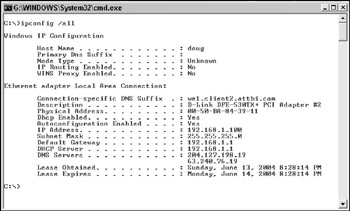Layer 2: The Data Link Layer
The Data Link Layer is the lowest layer at which meaning is assigned to the bits that are transmitted over the network. Data-link protocols address things, such as the size of each packet of data to be sent, a means of addressing each packet so that it's delivered to the intended recipient, and a way to ensure that two or more nodes don't try to transmit data on the network at the same time.
The Data Link Layer also provides basic error detection and correction to ensure that the data sent is the same as the data received. If an uncorrectable error occurs, the data-link standard must specify how the node is to be informed of the error so it can retransmit the data.
At the Data Link Layer, each device on the network has an address known as the Media Access Control address, or MAC address. This is the actual hardware address, assigned to the device at the factory.
You can see the MAC address for a computer's network adapter by opening a command window and running the ipconfig /all command, as shown in Figure 29-1. In this example, the MAC address (identified as the physical address in the output) of the network card is 00-50-BA-84-39-11.

Figure 29-1: Displaying the MAC address of your network adapter.
| TECHNICAL STUFF | One of the most import functions of the Data Link Layer is to provide a way for packets to be sent safely over the physical media without interference from other nodes attempting to send packets at the same time. Ethernet uses a technique called CSMA/CD to accomplish this. |
Switches are the most commonly used Data Link Layer devices in most networks. A switch is similar to a hub, but instead of regenerating incoming signals of every port, a switch examines the MAC address of every incoming packet to determine which port to send the packet to.